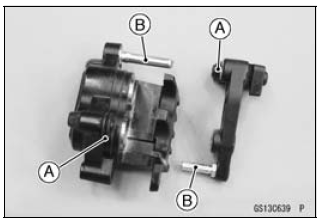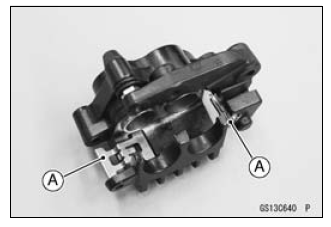 Kawasaki J300 - Service manual > Master Cylinder Rubber Parts
Replacement
Kawasaki J300 - Service manual > Master Cylinder Rubber Parts
Replacement
Master Cylinder Disassembly
- Remove the master cylinder (see Master Cylinder Removal in the Brakes chapter).
- Unscrew the locknut and pivot bolt, and remove the brake lever.
- Remove the piston assembly [A] as follows.
- Remove the dust cover [B] and circlip [C].
Special Tool - Inside Circlip Pliers: 57001-143
- Pull out the piston assembly.
- Remove the return spring [D].
- Replace:
Dust Cover
Circlip
Piston Assembly
Diaphragm [E]

Master Cylinder Assembly
- Before assembly, clean all parts including the master cylinder with brake fluid or alcohol.
NOTICE Except for the disc pads and disc, use only disc brake fluid, isopropyl alcohol, or ethyl alcohol for cleaning brake parts. Do not use any other fluid for cleaning these parts. Gasoline, engine oil, or any other petroleum distillate will cause deterioration of the rubber parts. Oil spilled on any part will be difficult to wash off completely, and will eventually deteriorate the rubber used in the disc brake.
- Apply brake fluid to the new parts and to the inner wall of the cylinder.
- Take care not to scratch the piston or the inner wall of the cylinder.
- Apply silicone grease to the brake lever pivot bolt.
- Tighten the brake lever pivot bolt and the locknut.
Torque -
Brake Lever Pivot Bolt: 2.0 N*m (0.20 kgf*m, 18 in*lb)
Brake Lever Pivot Bolt Locknut: 9.8 N*m (1.0 kgf*m, 87 in*lb)
Caliper Rubber Parts Replacement
Front Caliper Disassembly
- Remove:
Front Caliper (see Front Caliper Removal in the Brakes chapter)
Brake Pads (see Front Brake Pad Removal in the Brakes chapter)
Pad Spring
- Using compressed air, remove the pistons.
- Cover the caliper opening with a clean heavy cloth [A].
- Blow compressed air [B] into the hole for the banjo bolt to remove the piston.
WARNING The piston in the brake caliper can crush hands and fingers. Never place your hand or fingers in front of the piston.

- Pull out the pistons by hand.
- Remove:
Caliper Holder
Dust Seals
Fluid Seals
Bleed Valve
Rubber Cap
Front Caliper Assembly
- Clean the caliper parts except for the pads.
NOTICE For cleaning the parts, use only disc brake fluid, isopropyl alcohol, or ethyl alcohol.
- Install the bleed valve and rubber cap.
- Replace the fluid seals [A] and the dust seals [B] with new ones.
- Apply brake fluid to the seals, and install them into the cylinders by hand.

- Apply brake fluid to the outside of the pistons, and push them into each cylinder by hand.
- Check the friction boots [A] and replace them with new ones if they are damaged.
- Apply silicone grease to the caliper holder shafts [B].

- Install the pad springs [A].
- Install the pads (see Front Brake Pad Installation in the Brakes chapter).
- Wipe up any spilled brake fluid on the caliper with wet cloth.

Rear Caliper Disassembly
- Remove:
Rear Caliper (see Rear Caliper Removal in the Brakes chapter)
Brake Pads (see Rear Brake Pad Removal in the Brakes chapter)
Pad Spring - Using compressed air, remove the piston.
- Cover the caliper opening with a clean heavy cloth [A].
- Blow compressed air [B] into the hole for the banjo bolt to remove the piston.
WARNING The piston in the brake caliper can crush hands and fingers. Never place your hand or fingers in front of the piston.

- Pull out the pistons by hand.
- Remove:
Caliper Holder
Dust Seals
Fluid Seals
Bleed Valve
Rubber Cap
Rear Caliper Assembly
- Clean the caliper parts except for the pads.
NOTICE For cleaning of the parts, use only disc brake fluid, isopropyl alcohol, or ethyl alcohol.
- Install the bleed valve and rubber cap.
- Replace the fluid seals [A] and the dust seals [B] with new ones.
- Apply brake fluid to the seals, and install them into the cylinders by hand.

- Apply brake fluid to the outside of the pistons, and push them into each cylinder by hand.
- Check the friction boots [A] and replace them with new ones if they are damaged.
- Apply silicone grease to the caliper holder shafts [B].

- Install the pad springs [A].
- Install the pads (see Rear Brake Pad Installation in the Brakes chapter).
- Wipe up any spilled brake fluid on the caliper with wet cloth.

See also:
 Kawasaki J300 - Service manual > Brake System
Kawasaki J300 - Service manual > Brake System
Brake Fluid Leak Inspection For ABS equipped model, remove the front fairing (see Front Fairing Removal in the Frame chapter). Apply the brake lever and inspect the brake fluid leak from the brake hoses [A] and fittings [B].
 Kawasaki J300 - Service manual > Brake Pad Wear Inspection
Kawasaki J300 - Service manual > Brake Pad Wear Inspection
Remove the brake pads (see Front/Rear Brake Pad Removal in the Brakes chapter). Check the lining thickness [A] of the pads in each caliper. If the lining thickness of either pad is less than the service limit [B], replace both pads in the caliper as a set.







